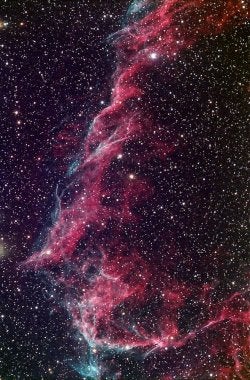A complex network of glowing filaments, the Veil Nebula has long been a favorite of both amateur and professional astronomers. Part of a much larger nebula known as the Cygnus Loop, the Veil is a middle-aged supernova remnant, the remains of a star that exploded some 5,000 to 8,000 years ago.
Scientists have spent the last 50 years probing the Cygnus Loop, trying to understand its physical characteristics and hoping to use it as a model for an entire class of similar objects that cannot be observed in such fine detail. But even under such intensive study, many of the Loop’s most basic parameters — its distance, the density of its gaseous filaments — remain unknown.
But a new observation of the star behind the Veil may change all that. Scientists from Johns Hopkins University used the Far Ultraviolet Spectroscopic Explorer (FUSE) satellite to observe the nebula and confirm that it’s much closer to Earth than previously thought. William Blair presented their results to the American Astronomical Society.
“It was a real stroke of luck,” Blair said. Last year, he and his colleagues pointed FUSE at the star, which is known only as KPD2055+311. By studying the UV spectrum, the astronomers were able to confirm that the star is, in fact, behind the Veil Nebula.
Once that was confirmed, the scientists were able to calculate the distance to the star: 1,860 light-years. Until 1999, astronomers thought the Cygnus Loop was more than 2,500 light-years away. Then, astronomers using the Hubble Space Telescope revised the estimate to 1,460 light-years, but the uncertainties in that measurement left many unconvinced.
FUSE, by determining the distance to a star behind the Veil, has placed an upper limit on the distance of the Loop and provided an independent confirmation of the shorter distance scale. The shorter distance makes a big difference in calculating the size, age, energy, and expansion velocity of the supernova remnant.










